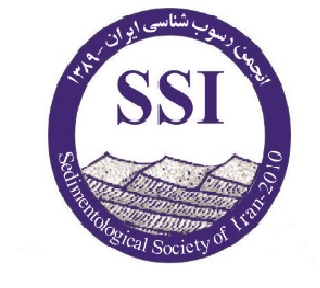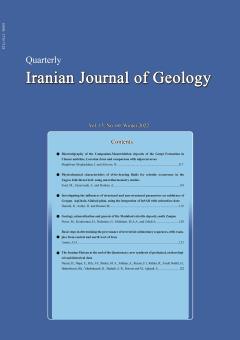Basic steps in determining the provenance of terrestrial sedimentary sequences, with examples from central and north west of Iran
Subject Areas :
1 - Tehran University
Keywords: Central Iran, Provenance, North West of Iran, Terrestrial facies.,
Abstract :
By stating the fundamental differences between terrestrial and detrital facies, this paper emphasizes on the limitations of provenance studies in terrestrial facies. Considering the presence of coarse-, medium- and fine-grained facies in most of terrestrial sedimentary sequences, the differences in textural and mineralogical characteristics, their study methods and possible differences in the provenance of these facies, the basic and necessary steps in studying these facies for determining the sedimentary provenance was investigated. In explaining these steps, some examples from terrestrial formations of Central Iran (Upper Red Formation) and north west of Iran (Zivar Formation) are presented. The role of diagenesis, structural deformation and paleogeography in the provenance study and their importance in this type of studies are explained. Finally, it is discussed how to proof the accuracy of the interpretations for the studied sedimentary sequences.
امینی، ع.، 1384. بررسي مشخصههای سنگشناسی و محيط رسوبي سازند زيور در ناحيه مغان. شرکت ملی نفت ایران، گزارش زمینشناسی شماره 2019 (GR- 2019)، 169.
دهخدا، ع.، 1377 . فرهنگ 15 جلدی دهخدا، چاپ دوم از دوره جدید. انتشارات دانشگاه تهران.
زمانزاده، م.، 1387. مشخصات سنگشناسی، محیط رسوبی و چینه نگاری سکانسی سازندهای زاکین و فراقون در برش تیپ. شمال بندرعباس. رساله دکتری، دانشکده زمینشناسی دانشگاه تهران. 241.
امینی، ع.، 1370. بررسی میکروفاسیسها و محیط رسوبی عضو F سازند قم در زون مرکزی ایران. پایاننامه کارشناسی ارشد ، دانشگاه تهران. 165.
Amini, A., 1997. Provenance and Depositional Environment of the Upper Red Formation, Central Zone, Iran: University of Manchester, Ph.D. Thesis (unpublished), 276.
Amini A. 2006. Oligo-Miocene fluvial-dominated deltas on the shelf of the south Caspian Sea (paratethys). Facies, 52: 579-597.
Amini, A., 2011. Use of feldspar grains in provenance determination and the study of transportation and depositional history, examples from central and NW Iran. Geopersia, 1(2), 11–24.
Amini A. and Anketell J.M., 2015. Textural and geochemical studies of detrital Fe-Ti oxides and test of their validity in provenance determination, a case study from Central Iran. Journal of African Earth Sciences, 103, 140-152.
Basu, A. and Molinaroli, E., 1989. Provenance characteristics of opaque Fe-Ti oxide minerals. Journal of Sedimentary petrology, 59, 922-934.
Basu, A., Molinaroli, E., 1991. Reliability and application of detrital opaque Fe-Ti oxide minerals in provenance determination. in: Morton, A.C., Todd, S.P. and Haughton, P.D.W. (Eds.) Development in sedimentary provenance studies. Geological Society of London, Special Publication 57, 55-65.
Bhatia, M.R., 1985. Composition and classification of Palaeozoic flysch mudrocks of eastern Australia: Implications in provenance and tectonic interpretation. Journal of sedimentary geology, 41, 249-268.
Carozzi, A.V., 1993. Sedimentary petrography. Prentice Hall, New York, 263.
Critelli, S., 2018. Provenance of Mesozoic to Cenozoic Circum-Mediterranean sandstones in relation to tectonic setting. Earth-Science Review, 85, 624–48.
Dickinson, W.R. and Suczek, C.A., 1979. Plate tectonics and sandstone compositions. American Association Petroleum Geology Bulletin, 63, 2164-2182.
Dickinson, W.R., 1985. Interpreting provenance relation from detailed modes of sandstones. In: Zuffa, G. G. (ed.) Provenance of arenites. NATO-ASI, Series 148, D. Reidel, Dordrecht, 333-361.
Folk, R.L., 1980. Petrology of sedimentary rocks. Hemphill Publication, Austin, Texas.
Hagerty, S.E., 1991. Oxide textures: a mini atlas. in: Lindsley, D.H. (ed.) Oxide minerals: Petrologic and magnetic significance. Reviews in mineralogy, 25, 129-219.
Haggerety, S.E., 1976a. Opaque mineral oxides in terrestrial igneous rocks. In: Rumble D. (ed.) Oxide minerals Mineral Society of American Short Course Notes, 3, 100-175.
Haggerty, S.E., 1976b. Oxidation of opaque oxides in basalts, In: Rumble D. (ed.) Oxide minerals Mineral Society of American Short Course Notes, 3, 1-100.
Ingersoil, R.V., Bullard, T.F., Ford, R.L., Grimm, J.P., Pickle, J.D. and Sares, S.W., 1984. The effects of grain size on detrital modes: A test of the Gazzi-Dickinson point-counting method. Journal of Sedimentary Petroleum, 54, 103-116.
Jafarzadeh, M., Moussavi Harami, R., Friis, H., Amini, A., Mahboubi, A. and Lenaz, D., 2014b. Provenance of the Oligocene–Miocene Zivah Formation, NW Iran, assessed using heavy mineral assemblage and detrital clinopyroxeneand detrital apatite analyses. Journal of African Earth Sciences, 89, 56-71.
Jaffarzade, M., Moussavi Harami, R., Amini, A., Mahboubi, A. and Farzaneh, F., 2014a. Geochemical constraints on the provenance of Oligocene–Miocene siliciclastic deposits (Zivah Formation) of NW Iran: implications for the tectonic evolution of the Caucasus. Arabian Journal of Geosciences, 7, 4245–4263
Katz, B., 1995. Petroleum source rocks. Springer-Verlag, 327.
Konert, G., Afifi, A.M., Al-Hajri, S.A. and Droste, H.J., 2001. Paleozoic Stratigraphy and Hydrocarbon Habitat of the Arabian Plate. GeoArabia, 6(3), 407-442.
McLennan, S.M., Hemming, S., McDaniel, D.K. and Hanson, G.N., 1993. Geo-chemical approaches to sedimentation, provenance and tectonics. In: Johnsson, M.J., and Basu A. (eds.) Processes Controlling theComposition of Clastic Sediments: Geological Society of American Special Publication, 284: 21–40.
Morton, A. C., Ellis, D., Fanning, M., Jolley, D. and Withman, A., 2012. The importance of an integrated approach to provenance studies: A case study from the Paleocene of the Faroe Shetland Basin, NE Atlantic. in: Rasbury, E.T., Hemming, S.R., Riggs, N.R. (eds.), Mineralogical and Geochemical Approaches to Provenance. The Geological Society of America, Special Paper 487, 1-12.
Morton, A.C., 1991. Geochemical studies of detrital heavy minerals and their application to provenance research. in: Morton, A.C., Todd, S.P. Haughton, P.D.W. (Eds.) Development in sedimentary provenance studies. Geological Society of London, Special publication, 57, 31-45.
Morton, A.C., Todd, S.P. and Haughton, P.D.W., 1991. Development in sedimentary provenance studies. Geological Society of London Special Publication, 57, 570.
Pettijohn, E.J., Potter, P.E. and Siever, R., 1987. Sand and Sandstone, 3rd ed. Springer, New York.
Pittman, E.D., 1970. Plagioclase feldspars as an indicator of provenance in sedimentary rocks. Journal of Sedimentary Petrology, 40, 591-598.
Potter, P.E., Maynard J.B. and Depetris, P.J., 2005. Mud and mudstones: introduction and overview. Springer, New York, 297.
Scott, R. A., Smyth H.R., Morton A.C. and Richardson N., 2014. Sediment provenamce studies in hydrocarbon exploration and production. Geological Society Lond Special publication # 386.
Selley, R.C., 1996. Ancient Sedimentary Environments and their Sub-surface Diagnosis. 4th ed., Nelson Thornes (Publisher) Ltd., England, 315.
Trevena, A.S. and Nash, W.P., 1979. Chemistry and provenance of detrital plagioclase. Geology, 7, 475-478.
Trevena A.S. and Nash, W.P., 1981. An Electron Microprobe study of detrital feldspars. Journal of Sedimentary Petrology, 51, 137-150.
Yan, Z., Wang, Z., Yan, Q., Wang, T. and Guo, X., 2012. Geochemical constraints on the provenance and depositional setting of the devonian Liuling group, East Qinling Mountains, Central China: implications for theTectonic Evolution of the Qinling Orogenic Belt. Journal of Sedimentary Research, 82, 9–24.
Zhang, M., Yu, Y., Choi, J., Cai, K. and Shi, M., 2020. Petrography and geochemistry of clastic sedimentary rocks as evidence for the provenance of the Jurassic stratum in the Daqingshan area.
Zoleikhaei, Y., Amini, A. and Zamanzadeh, M., 2015. Integrated provenance analysis of Zakeen (Devonian) and Faraghan (early Permian) sandstones in the Zagros belt, SW Iran. Journal African Earth sciences, 101, 148-161.
Zuffa, G.G., 1985. Optical analyses of arenites: influence of methodology on compositional results. in: Zuffa, G.G. (Ed.) Provenance of arenites. NATO-ASI, Series 148, Reidel, Dordrecht. 168-189.

